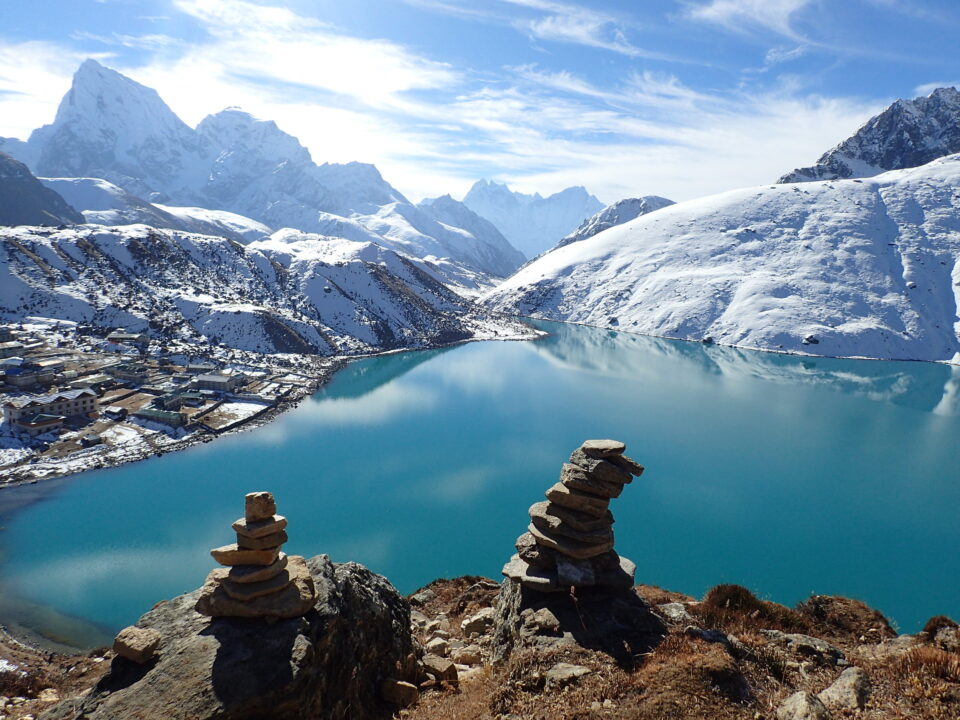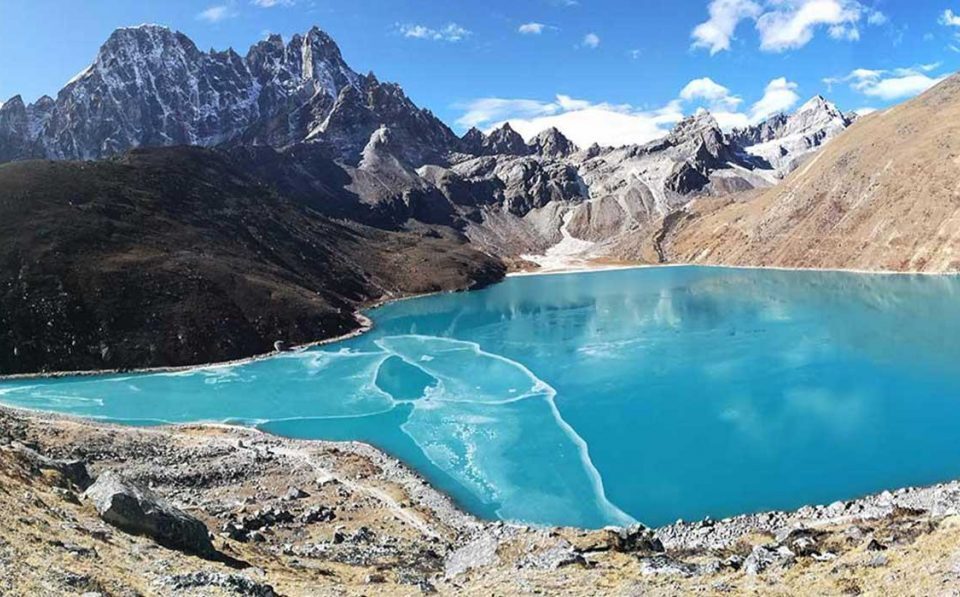Unveiling the Timeless Beauty of Bhaktapur Durbar Square

Unveiling the Timeless Beauty of Bhaktapur Durbar Square: Your Ultimate Guide to Nepal’s Architectural Gem
Welcome to Bhaktapur Durbar Square, a breathtaking ensemble of ancient palaces, courtyards, and temples that embody the rich cultural and historical heritage of Nepal. Located in the heart of Bhaktapur, a city often referred to as the “City of Devotees,” this UNESCO World Heritage site offers an unparalleled glimpse into Nepalese art, architecture, and history. This comprehensive guide provides everything you need to know for an enriching visit to Bhaktapur Durbar Square, including its history, key attractions, unique features, and practical information for tourists.
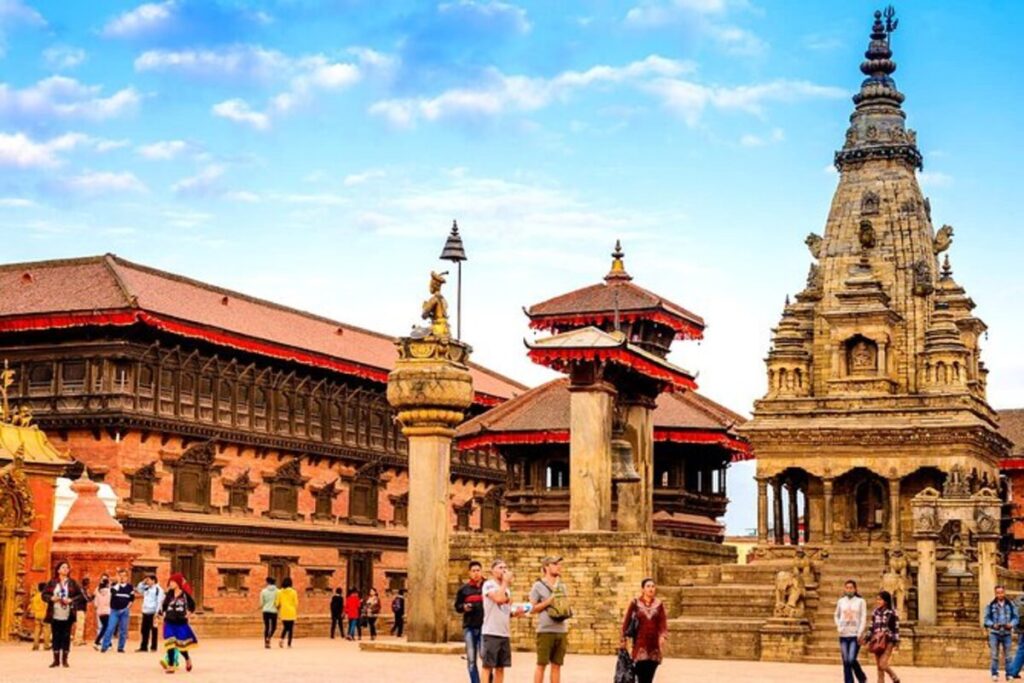
A Glimpse into the History of Bhaktapur Durbar Square
Early Beginnings
Bhaktapur, also known as Bhadgaon or Khwopa, has a rich history that dates back to the 12th century when it was founded by King Ananda Malla.
- Malla Dynasty: The Malla dynasty played a crucial role in the development of Bhaktapur, making it a center of culture, religion, and trade in the Kathmandu Valley.
- Royal Palace: The Royal Palace at Bhaktapur Durbar Square served as the residence of the Malla kings and was the administrative and ceremonial center of the city.
Cultural and Religious Significance
Bhaktapur Durbar Square is not only a historical site but also a vibrant cultural and religious hub.
- Festivals and Rituals: The square is the focal point of many of Bhaktapur’s religious festivals and rituals, such as the Bisket Jatra and Gai Jatra.
- Temple Complex: The area is home to numerous temples dedicated to Hindu gods and goddesses, reflecting the deep religious significance of the site.
UNESCO World Heritage Site
In 1979, Bhaktapur Durbar Square was designated a UNESCO World Heritage site, recognizing its cultural, historical, and architectural importance.
- Preservation Efforts: The designation has helped spur preservation efforts to maintain the square’s historic structures and cultural heritage, despite challenges such as the 2015 earthquake.
Key Attractions of Bhaktapur Durbar Square
55-Window Palace (Pachpanna Jhyale Durbar)
The 55-Window Palace is one of the most iconic structures in Bhaktapur Durbar Square.
- Architectural Masterpiece: Built during the reign of King Bhupatindra Malla in the 18th century, the palace features a remarkable facade with fifty-five intricately carved wooden windows.
- Golden Gate: The palace is accessed through the stunning Golden Gate (Sun Dhoka), a gilded entrance adorned with elaborate reliefs of deities and mythical creatures.
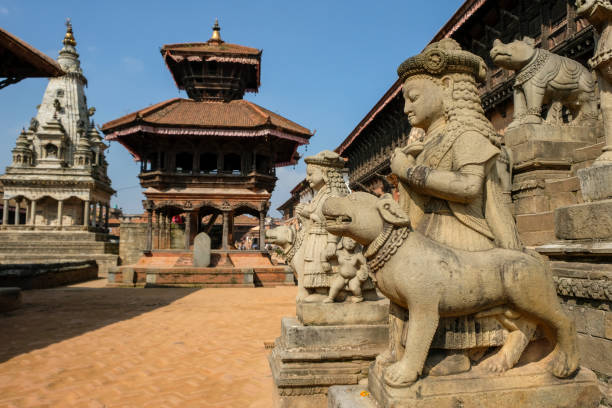
Vatsala Temple
The Vatsala Temple is known for its striking stone architecture and elaborate carvings.
- Shikhara Style: Built in the Shikhara style, the temple is dedicated to the goddess Vatsala Devi and features a detailed stone facade.
- Bell of Barking Dogs: The temple is home to the famous “Bell of Barking Dogs” (Vatsala Bell), which, according to legend, causes dogs to bark incessantly when rung.
Nyatapola Temple
Nyatapola Temple is the tallest temple in Nepal and a quintessential example of traditional Newari architecture.
- Five Tiers: The temple, built in 1702 by King Bhupatindra Malla, has five tiers, each representing one of the five basic elements. It stands at 30 meters tall.
- Guardian Statues: The temple is flanked by pairs of guardian statues, including wrestlers, elephants, lions, griffins, and goddesses, each believed to be ten times stronger than the figure below.
Bhairavnath Temple
The Bhairavnath Temple is dedicated to Bhairav, the fierce manifestation of Shiva.
- Pagoda Style: This three-story pagoda-style temple, originally built in the 16th century and later expanded by King Bhupatindra Malla, is known for its intricate wood carvings.
- Festivals: The temple plays a central role in many of Bhaktapur’s festivals, particularly the Bisket Jatra, where a chariot procession takes place.
Dattatreya Square
Dattatreya Square, located a short walk from the main Durbar Square, is another significant historical and cultural site.
- Dattatreya Temple: The temple, dedicated to the trinity of Brahma, Vishnu, and Shiva, is said to have been built from a single tree in 1427 AD.
- Woodcarving Museum: The nearby Pujari Math, a former priest’s residence, now serves as a museum showcasing exquisite woodcarvings and artifacts.
Unique Features of Bhaktapur Durbar Square
Architectural Marvels
Bhaktapur Durbar Square is a showcase of traditional Nepalese architecture, particularly the Newari style.
- Intricate Woodwork: The square is renowned for its intricate wood carvings, which adorn the windows, doors, and struts of the temples and palaces.
- Stone Sculptures: The area is dotted with stone sculptures, including statues of deities, mythical creatures, and historical figures, showcasing the artistic heritage of the Newars.
Living Culture
Bhaktapur Durbar Square is not just a historical site but a living part of the city’s culture and daily life.
- Festivals and Ceremonies: The square comes alive during festivals like Bisket Jatra and Gai Jatra, with traditional dances, music, and rituals.
- Artisans and Craftsmen: Local artisans and craftsmen continue to practice traditional skills in pottery, woodcarving, and weaving, contributing to the vibrant cultural atmosphere.
Practical Information for Tourists
Getting There
Bhaktapur Durbar Square is located in the city of Bhaktapur, about 13 kilometers east of Kathmandu, and is easily accessible by various modes of transportation.
- By Air: The nearest airport is Tribhuvan International Airport (KTM) in Kathmandu. From there, you can take a taxi or bus to Bhaktapur.
- By Road: Bhaktapur is well-connected by road, and taxis, buses, and rickshaws are readily available for transportation within the city.
Opening Hours and Tickets
Bhaktapur Durbar Square is open to visitors year-round.
- Opening Hours: The square is typically open from early morning until late evening, allowing ample time for exploration.
- Tickets: Entrance tickets are required for tourists and can be purchased at the main entrances. The fee helps fund preservation efforts and maintenance of the site.
Accessibility
While Bhaktapur Durbar Square strives to be accessible to all visitors, some areas may pose challenges due to uneven terrain and steps.
- Wheelchair Access: Certain parts of the square and museums may have limited wheelchair access. It’s advisable to check with local guides or authorities for specific accessibility information.
Tips for an Enjoyable Visit
Plan Your Visit
To make the most of your time at Bhaktapur Durbar Square, it’s helpful to plan ahead and prioritize the attractions and activities that interest you the most.
- Early Arrival: Arrive early to avoid the crowds and enjoy the site in the soft morning light, which is ideal for photography.
- Guided Tours: Consider joining a guided tour to gain deeper insights into the history and significance of Bhaktapur Durbar Square and its numerous features.
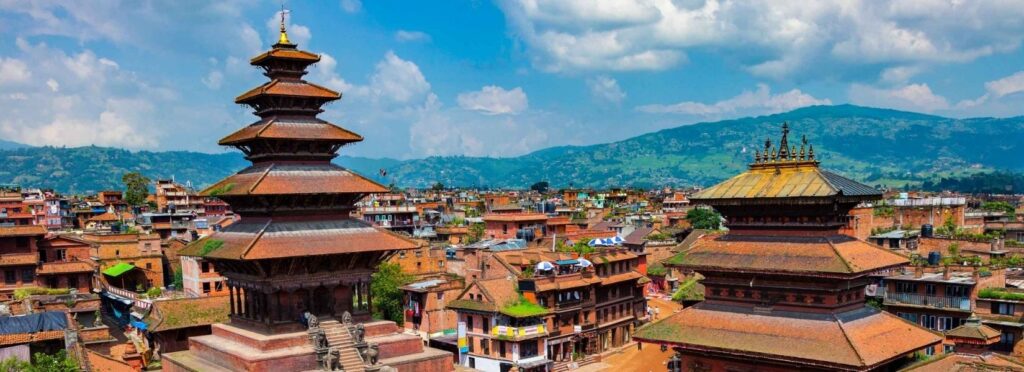
Capture the Moment
Bhaktapur Durbar Square offers numerous opportunities for stunning photographs. Here are some tips to capture the best shots:
- Golden Hour: Visit during the golden hour (just after sunrise or before sunset) for the best lighting and most beautiful photos.
- Panoramic Views: Capture the grandeur of the square from different angles, including the terraces of nearby buildings.
- Detail Shots: Don’t forget to take close-up shots of the intricate wood carvings, stone sculptures, and bustling market scenes.
Must-See Highlights at Bhaktapur Durbar Square
55-Window Palace (Pachpanna Jhyale Durbar)
The 55-Window Palace is one of the most iconic structures in Bhaktapur Durbar Square.
- Architectural Masterpiece: Built during the reign of King Bhupatindra Malla in the 18th century, the palace features a remarkable facade with fifty-five intricately carved wooden windows.
- Golden Gate: The palace is accessed through the stunning Golden Gate (Sun Dhoka), a gilded entrance adorned with elaborate reliefs of deities and mythical creatures.
Vatsala Temple
The Vatsala Temple is known for its striking stone architecture and elaborate carvings.
- Shikhara Style: Built in the Shikhara style, the temple is dedicated to the goddess Vatsala Devi and features a detailed stone facade.
- Bell of Barking Dogs: The temple is home to the famous “Bell of Barking Dogs” (Vatsala Bell), which, according to legend, causes dogs to bark incessantly when rung.
Nyatapola Temple
Nyatapola Temple is the tallest temple in Nepal and a quintessential example of traditional Newari architecture.
- Five Tiers: The temple, built in 1702 by King Bhupatindra Malla, has five tiers, each representing one of the five basic elements. It stands at 30 meters tall.
- Guardian Statues: The temple is flanked by pairs of guardian statues, including wrestlers, elephants, lions, griffins, and goddesses, each believed to be ten times stronger than the figure below.
Bhairavnath Temple
The Bhairavnath Temple is dedicated to Bhairav, the fierce manifestation of Shiva.
- Pagoda Style: This three-story pagoda-style temple, originally built in the
16th century and later expanded by King Bhupatindra Malla, is known for its intricate wood carvings.
- Festivals: The temple plays a central role in many of Bhaktapur’s festivals, particularly the Bisket Jatra, where a chariot procession takes place.
Dattatreya Square
Dattatreya Square, located a short walk from the main Durbar Square, is another significant historical and cultural site.
- Dattatreya Temple: The temple, dedicated to the trinity of Brahma, Vishnu, and Shiva, is said to have been built from a single tree in 1427 AD.
- Woodcarving Museum: The nearby Pujari Math, a former priest’s residence, now serves as a museum showcasing exquisite woodcarvings and artifacts.
Dining and Shopping in Bhaktapur Durbar Square
Dining Options
Bhaktapur Durbar Square offers a variety of dining options, ranging from traditional Nepalese cuisine to international dishes.
- Local Cuisine: Try traditional dishes such as momo (dumplings), dal bhat (lentil soup with rice), and Newari specialties like yomari and choila.
- Cafes and Restaurants: Enjoy a meal or a drink at one of the many cafes and restaurants around the square, offering outdoor seating with views of the historic sites.
Shopping for Souvenirs
The shops in and around Bhaktapur Durbar Square offer a wide range of souvenirs, local products, and artisan crafts that make perfect mementos of your visit.
- Handicrafts: Look for handmade crafts, pottery, and jewelry created by local artisans, reflecting the cultural heritage of Nepal.
- Thangka Paintings: Purchase a thangka painting, a traditional Tibetan Buddhist artwork that is both beautiful and meaningful.
- Pashmina: Take home a pashmina shawl, known for its softness and quality, as a reminder of your visit to Nepal.
Practical Tips for Visitors
Best Time to Visit
The best time to visit Bhaktapur Durbar Square is during the spring (March to May) and autumn (September to November), when the weather is mild and clear.
- Peak Season: These periods are the peak tourist seasons, offering the best weather for exploring the square and other attractions in Bhaktapur.
- Off-Peak Season: Visiting during the winter (December to February) or the monsoon season (June to August) may result in fewer crowds, but weather conditions can be less favorable.
Guided Tours and Audio Guides
To enhance your visit, consider joining a guided tour or renting an audio guide.
- Guided Tours: The site offers guided tours led by knowledgeable guides who provide in-depth information about the history, architecture, and significance of Bhaktapur Durbar Square.
- Audio Guides: Audio guides are available in multiple languages and provide detailed commentary on the key features and highlights of the square.
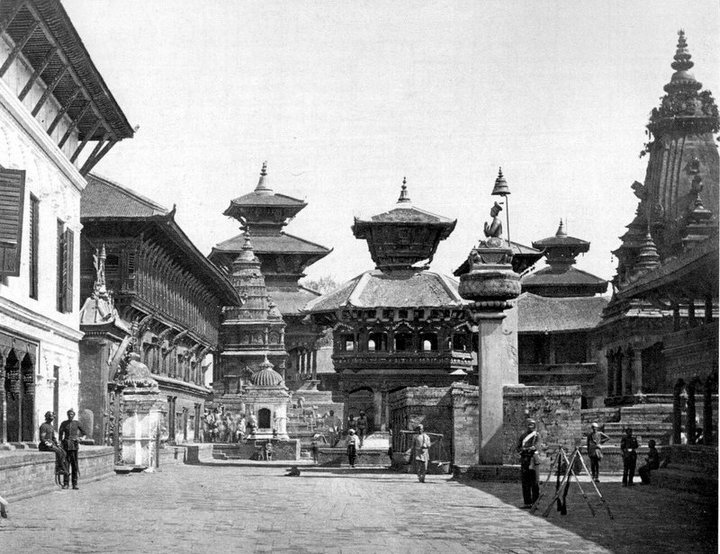
Conclusion
Bhaktapur Durbar Square stands as a testament to the grandeur and ingenuity of Nepalese architecture and culture, offering visitors an unparalleled journey through history and tradition. From the awe-inspiring 55-Window Palace and the sacred Nyatapola Temple to the vibrant markets and living culture, Bhaktapur Durbar Square provides an unforgettable experience for all who visit. Plan your trip to Bhaktapur Durbar Square and immerse yourself in the beauty, history, and mystique of this iconic symbol of Nepal’s rich heritage. Embrace the opportunity to explore, discover, and create lasting memories in this magnificent cultural and historical treasure.

